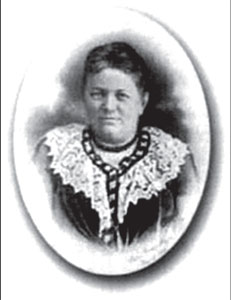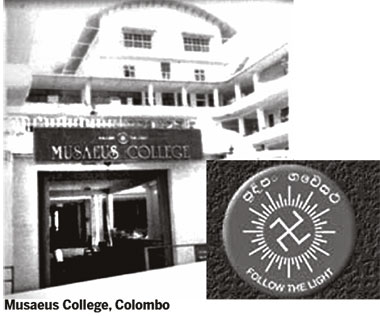Musaeus, mother and mentor from America...
The beginnings of Musaeus College (101st anniversary of Marie Musaeus
Higgins' arrival and 99th anniversary of laying of foundation stone)
Marie Musaeus Higgins was born on May 18, 1855 in Wismar, in the Duchy
of Mecklenburg-Schwerin, Germany where her father Theodore Mussaeus was
a forestry magistrate. Her brother Friedrich emigrated to the United
States of America and she joined him there in the 1880s.
|

Marie Musaeus Higgins |
She worked for the government in Washington DC, where she met and
married Anton Higgins, a Theosophist. She was herself a founder of the
Blavatsky Theosophist Lodge. After her husband’s death she looked around
for a method of benefitting humanity through education and Theosophy.
She read a notice placed in The Path, the US organ of the
Theosophists, by Peter de Abrew of the Buddhist Theosophical Society
(BTS), asking for a Principal for the new Buddhist girls’ high school in
Colombo.
Vernacular schools
In the late 19th Buddhist parents did not send their daughters to
Christian missionary schools, fearing that they would be converted. In
the absence of an alternative, Buddhist women remained uneducated, with
a literacy rate of only 2.6 percent.
On March 30, 1889, a group of women gathered at the Maliban Street
headquarters of the BTS, and formed the Women's Education Society of
Ceylon (WES) - Nari-shiksa-dhana Samagama in Sinhala - to promote the
education of Buddhist women.
The society established several vernacular schools, but its ambition
was to set up an English-language girls’ high school, analogous with
Ananda College, the first Buddhist English-language boys high school.
Accordingly, the Sangamitta Girls’ School was opened on October 18,
1890 at Tichborne Place, Maradana. The WES wished to have a European
Principal for the school, which had an average attendance of 70-80
children.
Hence Peter de Abrew’s advertisement in The Path, which looked for a
woman who ‘should not only be versed in educational matters, but should
likewise have some knowledge of Buddhism and other Oriental
philosophies; above all, she should be a Theosophist.’

Marie Musaeus Higgins’ heart went out to the girls of Sri Lanka. She
responded immediately, writing to de Abrew that she would ‘undertake to
be a mother to the daughters of Lanka’. Delighted, the WES accepted her
application and she made arrangements to travel to Colombo.
Unfortunately a mix-up ensued. Visiting Sydney and Melbourne in
search of funds for the new school, the Theosophical Society’s
co-founder Colonel Henry Olcott put the need for a European Principal to
the Theosophists there. Kate Pickett, the 23 year-old daughter of the
Melbourne TS president, Elise Pickett, volunteered for the task.
Olcott later straightened the matter out with Musaeus, explaining
that she would be General Directress of the work of the WES, advising it
and superintending its schools, as well as being the Principal of one of
two major schools, either Colombo or Kandy - the other Principal being
Kate Pickett; Musaeus was also to be the senior of the two. Kate Pickett
arrived in Colombo on the steamer Salier, on June 10, 1891, and took up
her duties at Tichborne Hall. Unfortunately, she drowned within two
weeks of her arrival. Luckily, Musaeus was on the way, the post of
acting principal being taken up by Louisa Roberts Ratnaweera.
New premises
Musaeus arrived on the steamer Preussen on November 15, and took over
from Roberts, who reverted to assistant teacher. She immediately plunged
into her task, which was to ‘bring the school to ship-shape order’. In
addition to Roberts, she was assisted by Elise Pickett, Kate’s mother
and, from September 1892 by Dr WA English of Massachusetts, his daughter
and Emma Allison.
In addition to the tasks connected with girls’ education, she also
lectured villagers and carried out Theosophical missionary activities
among ships’ sailors and passengers through the Colombo ‘Harbour
Mission’. Her biggest problem was lack of money, because the authorities
would not approve the school for grant-in-aid. Therefore she and her
colleagues solicited funds, going house to house, daily. The monthly
rent of Rs 50 for Tichborne Hall was especially taxing, so a committee
was established to collect funds for buying new premises.
Two years after Musaeus’ arrival, on November 15, 1893 Annie Besant
laid the foundation stone for the new building for Sanghamitta School on
November 15, 1893 on a half acre of land donated by Peter de Abrew and
his father William at Rosmead Place, Cinnamon Gardens.
However, due to differences with members of WES, Musaeus resigned
from her position on December 15, 1893. She started her own school with
12 girls, classes commencing in a cadjan-thatched wattle and daub
building – which Musaeus called her ‘mud palace’ – on the Rosmead Place
land the following February.
Peter de Abrew departed for London, where he implored members of the
Theosophical Society to aid the fledgling institution.
'It is my intention', he wrote in the Theosophist magazine Lucifer,
'that the school shall be entirely undenominational, as by adopting that
method I shall be enabled to benefit all my countrywomen without
distinction of creed... My object is first of all to put the blessings
of a good sound general education within reach of all my countrywomen,
and I can best do that by leaving religious instruction to be given by
the various denominations in their Sunday schools.'
However, it was due to an Australian Theosophist, artist, traveller,
lecturer and utopist Wilton Hack (later President of Dharmaraja College,
Kandy) that the school received its first brick building, which was
completed in 1895.
Two years after its foundation the school received grant-in-aid
status, and a board of trustees was appointed to oversee the school,
including Musaeus, Olcott, Dr. William Austin, Peter de Abrew and Wilton
Hack.
In 1902, one of the first dozen students, Lucy de Abrew, received the
Jeejeebhoy scholarship, the first woman to do so, and became the first
Sinhalese woman to enter the Medical College. Another of the first
dozen, Jane de Zoysa, became founder Principal of the Musaeus Teacher
Training College. A decade later, an Australian Theosophist, suffragette
and educationist, Annie Eliza Preston, joined the staff. In 1922 the
Musaeus Nursery School was inaugurated, with her as its head. She went
on to found Alathea School in 1928.
Marie Musaeus Higgins passed away on July 10, 1926, Peter de Abrew
fourteen years later. Wilton Hack had predeceased them both in 1923 - he
remained a trustee to his death.
The educational institution they founded and fostered remains a
living monument to the contribution of the Theosophists to female
education in Sri Lanka. |







